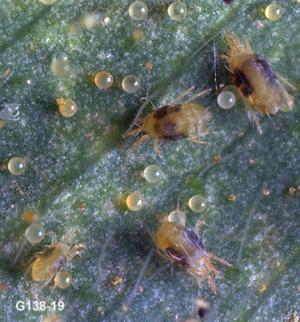|
TWOSPTTED SPIDER MITE LIFE CYCLE AND BIOLOGY | |
CONTENTS |
Twospotted spider mites, Tetranychus urticae, are tiny (0.25 to 0.5 mm long) eight-legged arthropods with two large spots on both sides of the body. Mites are typically found on the undersides of leaves, but may colonize entire plants during outbreaks. Silk webbing on the undersides of leaves, and bronzing, stippling and burning of leaves are characteristic signs of spider mites. Damaged leaves drop from the plant.
The female mites overwinter in the soil and in
plant debris in and around mint fields. Females become active in the spring as
temperatures warm, and they begin depositing eggs on the undersides of leaves. Eggs hatch
in 4 to 5 days and the entire life cycle from egg to adult may require 1 to 3 weeks,
depending on the temperature. Infestations of mites may occur as early as March during
warm weather. During the summer months, mite populations can increase very quickly,
particularly in hot, dry weather, along dusty roads, during periods of water stress and
even in response to insecticide applications. Therefore, fields should be inspected at
least weekly to detect the buildup of damaging populations. |


